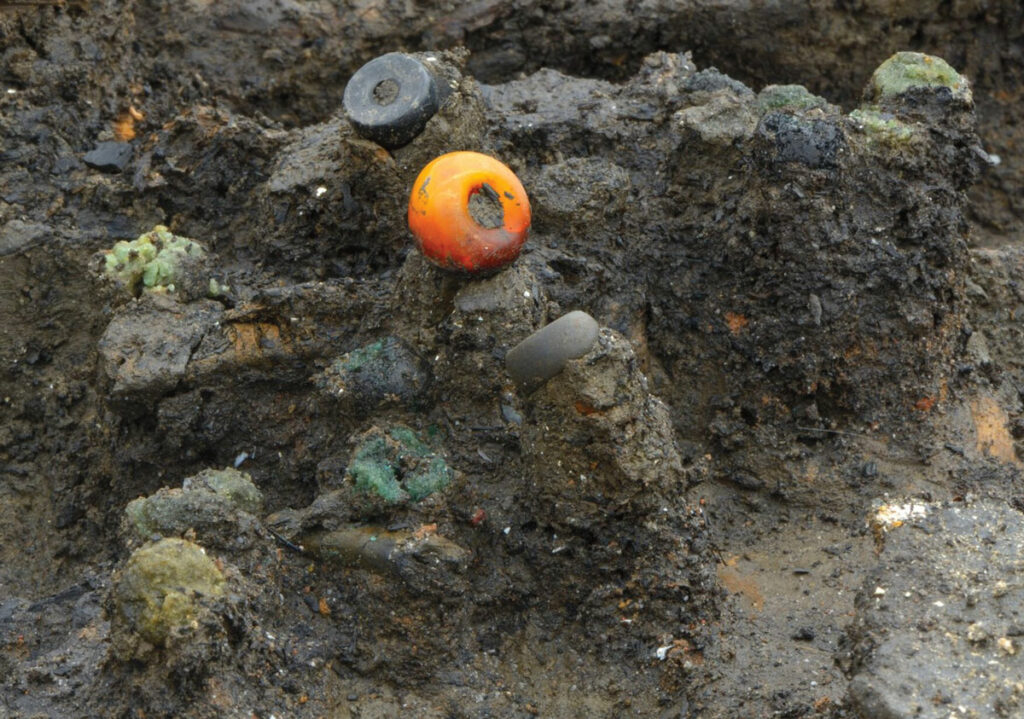The smallest artifacts can sometimes reveal surprisingly distant connections. In 2015, archaeologists began excavating one of England’s most intriguing sites, the British Bronze Age (2500–800 B.C.) settlement known as Must Farm. This village of perhaps 60 inhabitants in eastern England was built sometime around 850 B.C. After just a year, it burned down and was preserved nearly intact by the oxygen-free conditions of the muddy river into which it sank. Archaeologists raced to explore the site because the brick company that owned the land planned to reopen a clay quarry there. The researchers quickly unearthed five complete circular houses and a number of wooden walkways once perched six feet above a river that no longer exists, all surrounded by a six-foot-high fence of sharpened posts. They also uncovered a wide range of metal tools and weapons, more than 100 ceramic and wooden pots and storage bowls—some still containing porridge—Britain’s finest collection of Bronze Age textiles, and even a three-foot-diameter wooden wheel. (See “Fire in the Fens,” January/February 2017.) Given the pressures of the rescue excavation—and the threat to the plethora of finds that were exposed to air, and thus decay, for the first time in nearly three millennia—the archaeologists might have missed 56 tiny beads scattered across the site.
The majority of the beads are blue and green glass—the largest collection of glass beads from a Bronze Age site in Britain—while the rest are amber, siltstone, shale, tin, and faience, or tin-glazed earthenware. Since the beads were unearthed, scientists have used the most sophisticated techniques available to determine their provenance—and the results have been surprising. While Must Farm’s inhabitants would have sourced the food they ate and most of the materials they used locally, all the beads came from some distance away; most had traveled thousands of miles. According to archaeologist Alison Sheridan of National Museums Scotland, the shale beads, which were probably once part of a necklace, came from Dorset on England’s south coast, and the siltstone bead was also of English origin. The amber bead had probably been made in Ireland using amber imported from Denmark. It, too, was likely once part of a necklace. The tin bead came from Switzerland, and the faience bead from Egypt or Mesopotamia.
But the glass beads had journeyed farthest. “It’s really extraordinary that all but one of the glass beads, or at least the glass used to make them, originally derived from Iran,” says archaeologist Julian Henderson of the University of Nottingham. “Beads were imported to Late Bronze Age sites in Europe as part of international trade networks, but we didn’t know they included Iran until now.” Late Bronze Age communities had rich connections to the wider world via extensive networks of contacts, explains Sheridan. “Must Farm shouldn’t be seen as some kind of marketplace or hub for exchanging goods,” she says. “Rather, its inhabitants should be viewed as cosmopolitan and very well-connected individuals who could access exotic items from diverse locations.” They mixed some of the imported beads to make a composite necklace, with the amber, siltstone, and one of the shale beads as the centerpiece, flanked by some of the glass beads. “This necklace would have been very striking, with the shiny, translucent glass and amber beads glowing in the sunlight,” says Sheridan. “The prestige of this array of exotica shouldn’t be underestimated.” Beads from a necklace, Must Farm, England(Courtesy Cambridge Archaeological Unit)
Beads from a necklace, Must Farm, England(Courtesy Cambridge Archaeological Unit)
While the networks that brought the beads such a distance were expansive, the connections were not direct. “A bead made in Ireland using amber from Denmark didn’t travel directly to Must Farm,” Sheridan says. “Instead, a necklace would get broken up over time and its beads might be passed on as precious gifts.” Amber would have been highly valued. Its yellowish color and translucency made it glow in bright light, evoking the sun, and it was thought to have magical properties due to being electrostatic, warm to the touch, and able to float and, normally, burn. “The fact that the Must Farm amber bead survived the conflagration is truly remarkable,” Sheridan says. It is equally extraordinary that the glass beads were transported across such distances after what scholars agree was a dramatic period of societal and cultural collapse across Greece, Egypt, Mesopotamia, and Anatolia around 1200 B.C. “I wouldn’t have expected that contacts with Iran existed following this breakdown of social, economic, and ritual structures,” Henderson says. Furthermore, the beads were made of a type of glass not seen in Britain before. “Glassmakers innovated with new raw materials as a reaction to the collapse,” says Henderson. Forty-nine of these cutting-edge glass beads found their way 2,800 miles to Must Farm.


